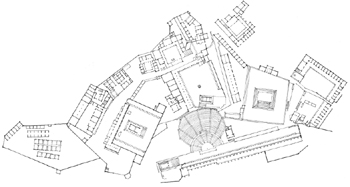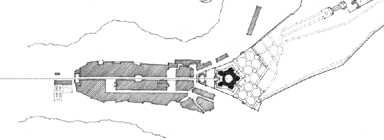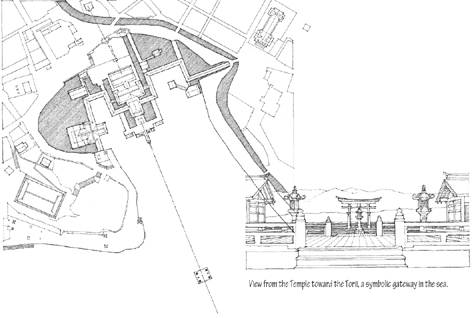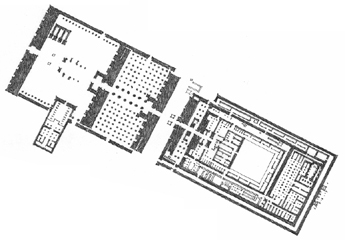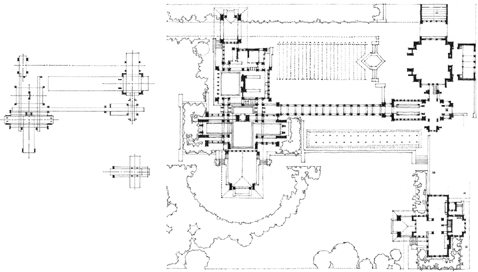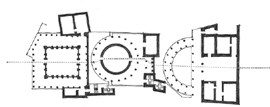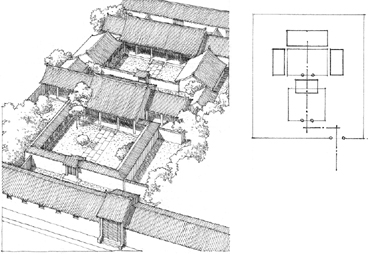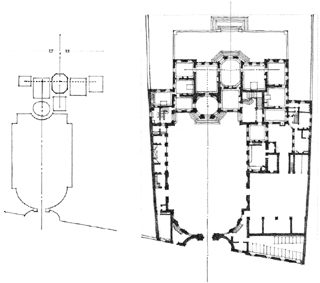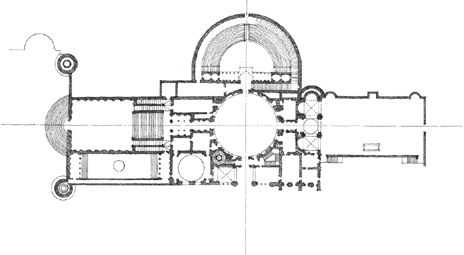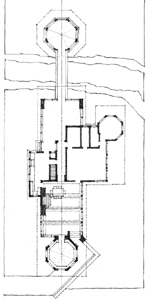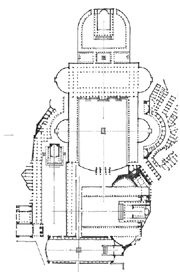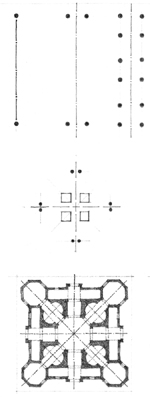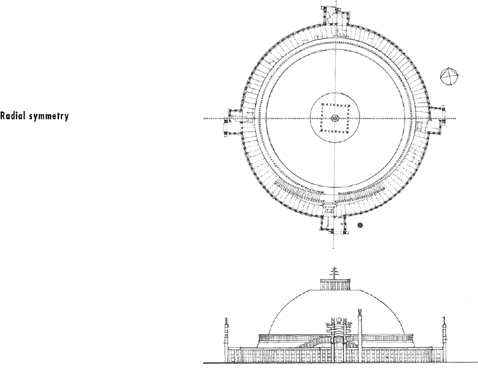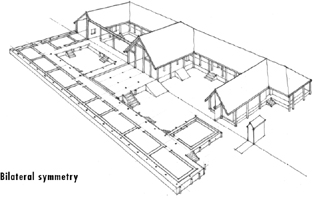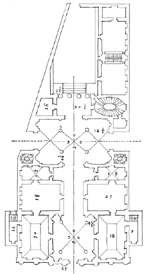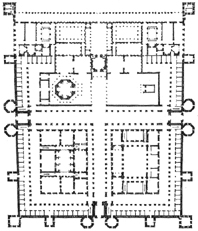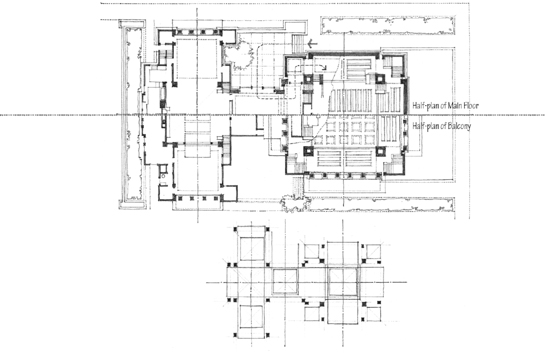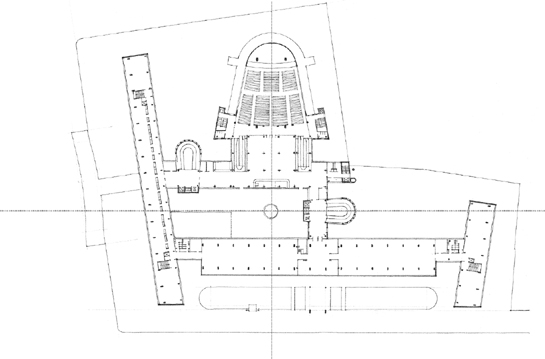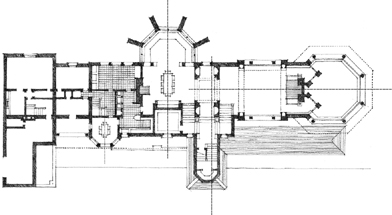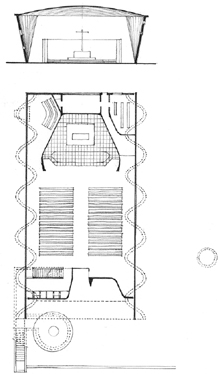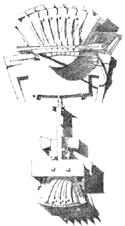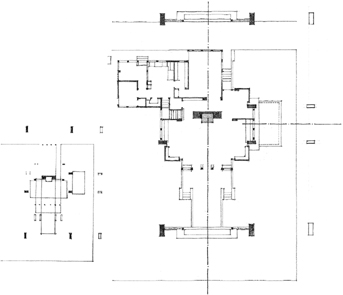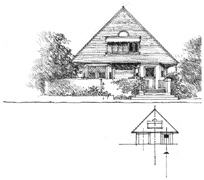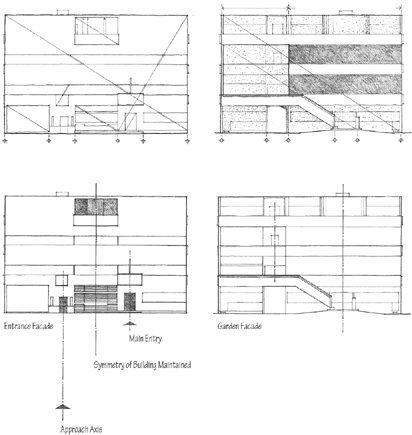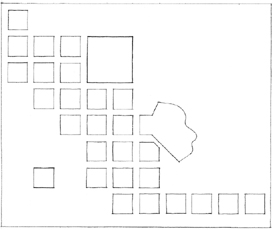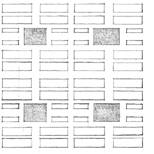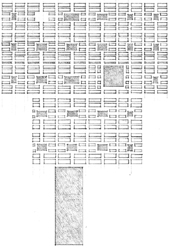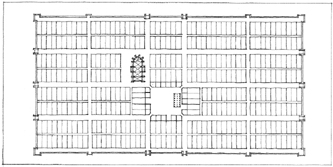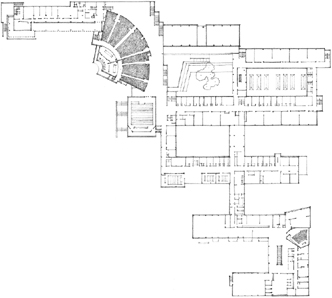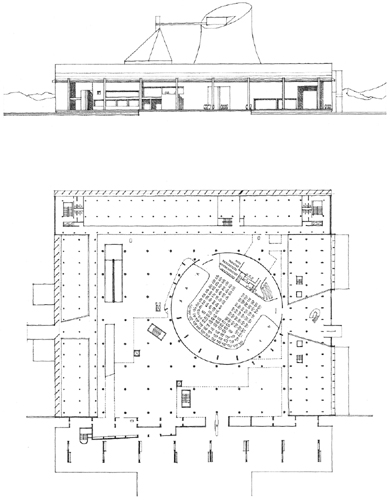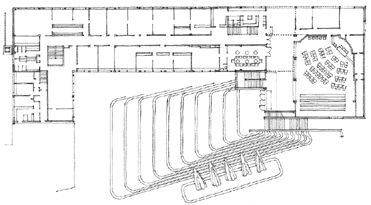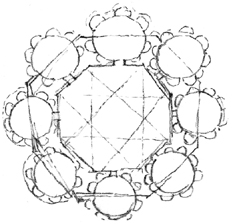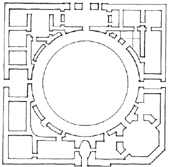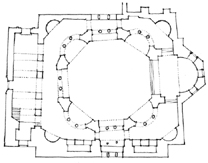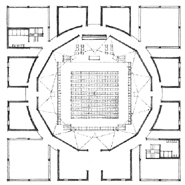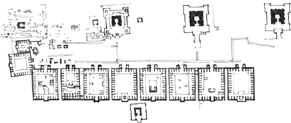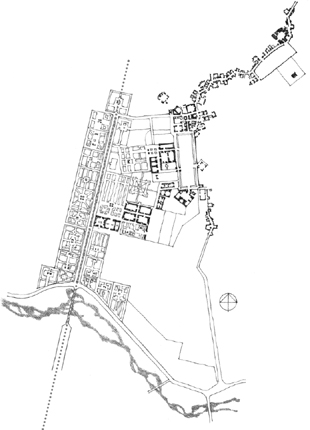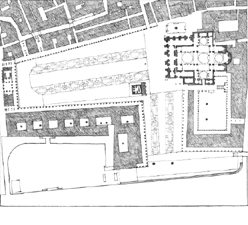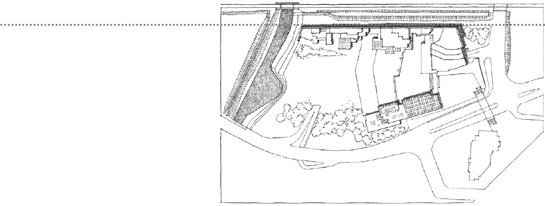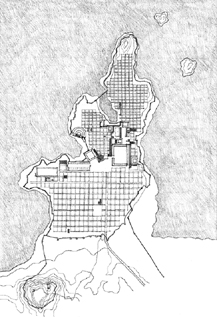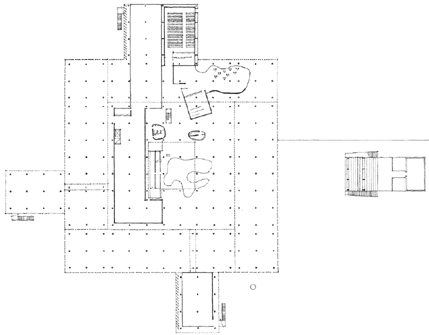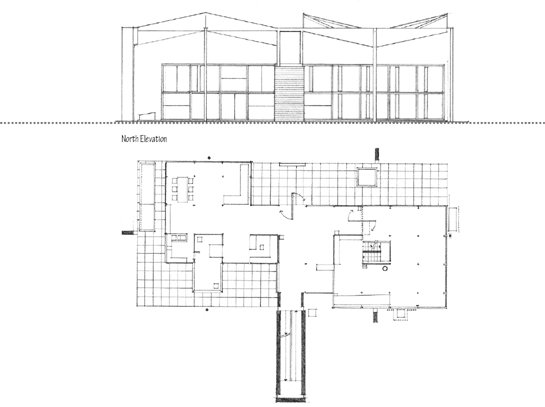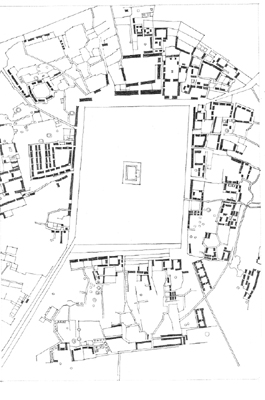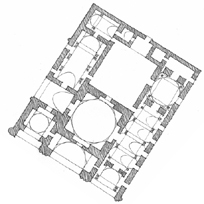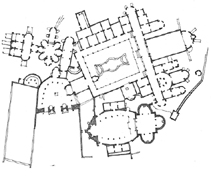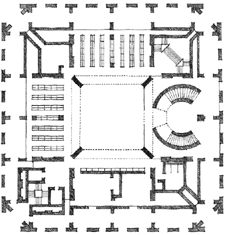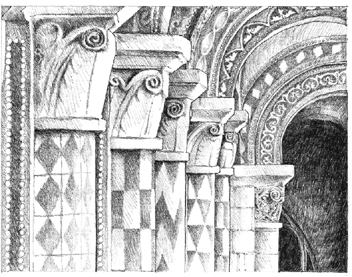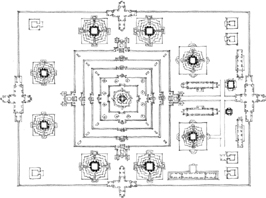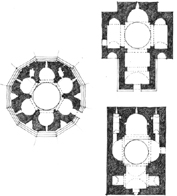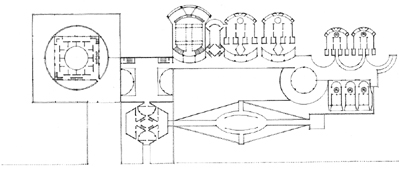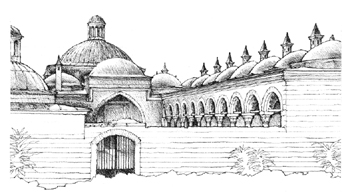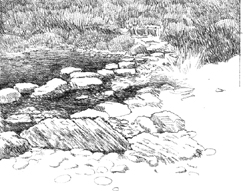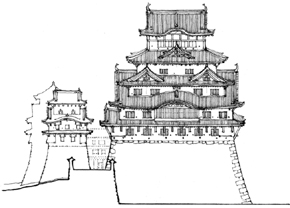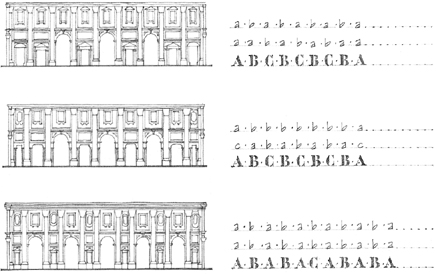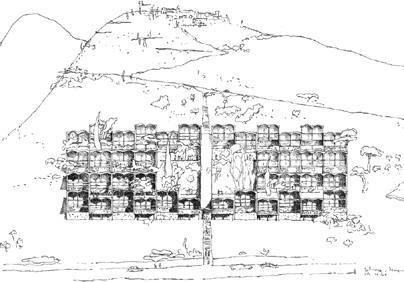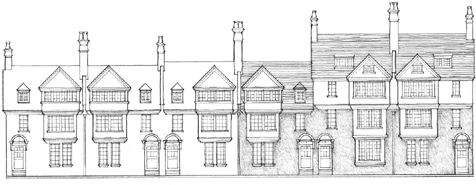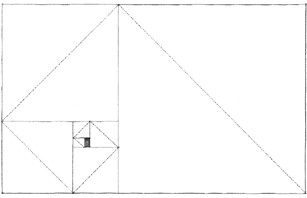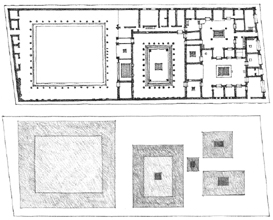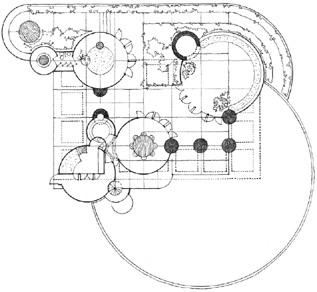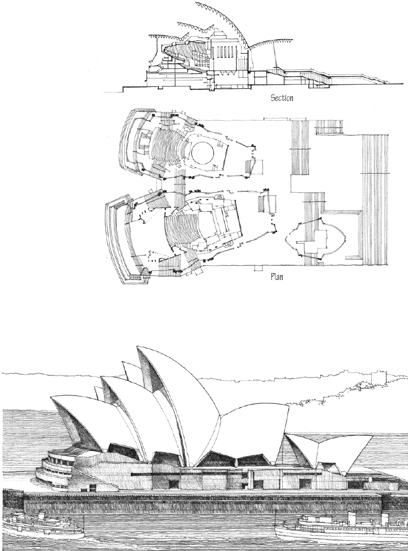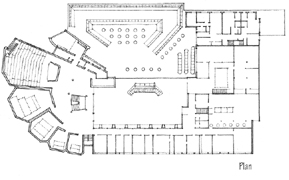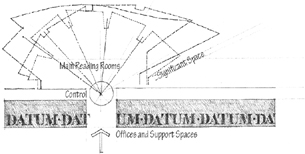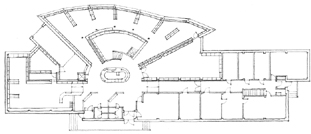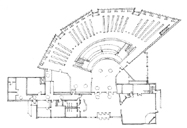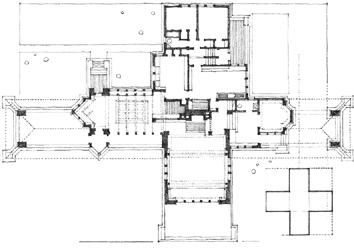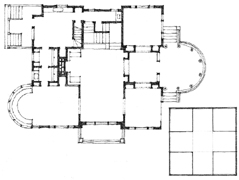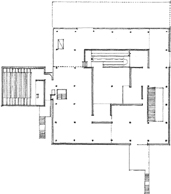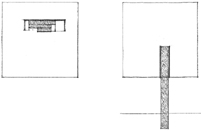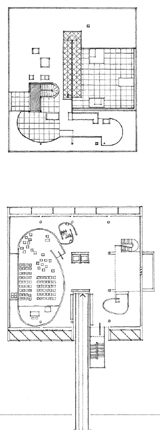Chapter 7
Principles
“… Nothing but confusion can result when order is considered a quality that can equally well be accepted or abandoned, something that can be forgone and replaced by something else. Order must be understood as indispensable to the functioning of any organized system, whether its function be physical or mental. Just as neither an engine nor an orchestra nor a sports team can perform without the integrated cooperation of all its parts, so a work of art or architecture cannot fulfill its function and transmit its message unless it presents an ordered pattern. Order is possible at any level of complexity: in statues as simple as those on Easter Island or as intricate as those by Bernini, in a farmhouse and in a Borromini church. But if there is not order, there is no way of telling what the work is trying to say.”
Rudolf Arnheim
The Dynamics of Architectural Form
1977
ORDERING PRINCIPLES
While Chapter 4 employed a geometric basis for organizing the forms and spaces of a building, this chapter discusses additional principles that can be utilized to create order in an architectural composition. Order refers not simply to geometric regularity, but rather to a condition in which each part of a whole is properly disposed with reference to other parts and to its purpose so as to produce a harmonious arrangement.
There exists a natural diversity and complexity in the program requirements
for buildings. The forms and spaces of any building should acknowledge the hierarchy inherent in the functions they accommodate, the users they serve, the purposes or meaning they convey, and the scope or context they address.
It is in recognition of this natural diversity, complexity, and hierarchy in the programming, designing, and making of buildings that ordering principles are discussed.
Order without diversity can result in monotony or boredom; diversity without order can produce chaos. A sense of unity with variety is the ideal. The following ordering principles are seen as visual devices that allow the varied and diverse forms and spaces of a building to coexist perceptually and conceptually within an ordered, unified, and harmonious whole.
Axis
A line established by two points in space, about which forms and spaces can be arranged in a symmetrical or balanced manner.

Symmetry
The balanced distribution and arrangement of equivalent forms and spaces on opposite sides of a dividing line or plane, or about a center or axis.

Hierarchy
The articulation of the importance or significance of a form or space by its size, shape, or placement relative to the other forms and spaces of the organization.

Rhythm
A unifying movement characterized by a patterned repetition or alternation of formal elements or motifs in the same or a modified form.

Datum
A line, plane, or volume that, by its continuity and regularity, serves to gather, measure, and organize a pattern of forms and spaces.

Transformation
The principle that an architectural concept, structure, or organization can be altered through a series of discrete manipulations and permutations in response to a specific context or set of conditions without a loss of identity or concept.

AXIS
The axis is perhaps the most elementary means of organizing forms and spaces in architecture. It is a line established by two points in space, about which forms and spaces can be arranged in a regular or irregular manner. Although imaginary and not visible except to the mind’s eye, an axis can be a powerful, dominating, regulating device. Although it implies symmetry, it demands balance. The specific disposition of elements about an axis will determine whether the visual force of an axial organization is subtle or overpowering, loosely structured or formal, picturesque or monotonous.
This Florentine street flanked by the Uffizi Palace links the River Arno to the Piazza della Signoria. See plan on pg. 342.
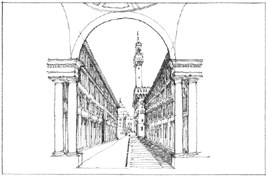
Since an axis is essentially a linear condition, it has qualities of length and direction, and induces movement and promotes views along its path.

The notion of an axis can be reinforced by defining edges along its length. These edges can be simply lines on the ground plane, or vertical planes that define a linear space coincident with the axis.

The terminating elements of an axis serve to both send and receive its visual thrust. These culminating elements can be any of the following:
• vertical planes, such as symmetrical building facades or fronts, preceded by a forecourt or similar open space

The wings of the Uffizi Palace in Florence, Italy, (1560, Giorgio Vasari) frame an axial space that leads from the River Arno, through the Uffizi arch, to the Piazza della Signoria and the Palazzo Vecchio (1298–1314, Arnolfo di Cambio).
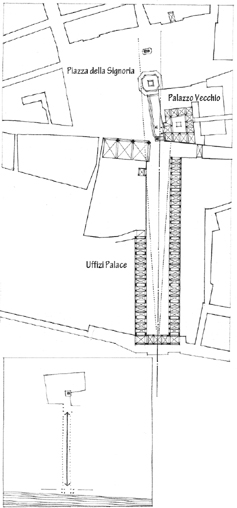
Teotihuacan, City of the Gods. Located near Mexico city, Teotihuacan was the largest and most influential ritual center of Mesoamerica, founded c. 100 B.C. and flourishing until about A.D. 750. The site was dominated by two massive temple-pyramids, the Pyramid of the Sun and the smaller Pyramid of the Moon, from which the Avenue of the Dead runs south to the citadel and market compound in the center of the city.
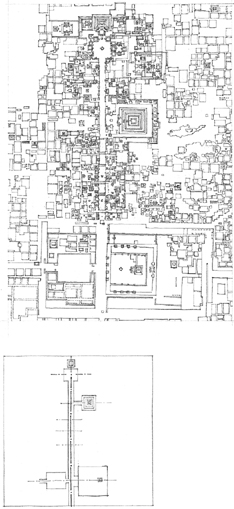
Plan of Beijing, China. Located on its north-south axis is the Forbidden City, a walled section within the inner city, built in the 15th century and containing the Imperial Palace and other buildings of the imperial government of China. It was so named because it was formerly closed to the public.

Torii is a monumental, freestanding gateway on the approach to a Shinto shrine, consisting of two pillars connected at the top by a horizontal crosspiece and a lintel above it, usually curving upward.
Northern Palace at Masada, Israel, c. 30–20 B.C. Axial conditions can persist across changes of topography and despite subtle shifts in alignment.
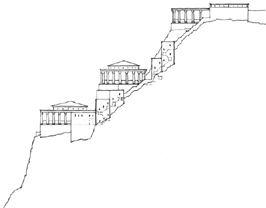
SYMMETRY
While an axial condition can exist without a symmetrical condition being simultaneously present, a symmetrical condition cannot exist without implying the existence of an axis or center about which it is structured. An axis is established by two points; a symmetrical condition requires the balanced arrangement of equivalent patterns of form and space on opposite sides of a dividing line or plane, or about a center or axis.
There are two fundamental types of symmetry:
1. Bilateral symmetry refers to the balanced arrangement of similar or equivalent elements on opposite sides of a median axis so that only one plane can divide the whole into essentially identical halves.
2. Radial symmetry refers to the balanced arrangement of similar, radiating elements such that the composition can be divided into similar halves by passing a plane at any angle around a centerpoint or along a central axis.
An architectural composition can utilize symmetry to organize its forms and spaces in two ways. An entire building organization can be made symmetrical. At some point, however, any totally symmetrical arrangement must confront and resolve the asymmetry of its site or context.
A symmetrical condition can occur in only a portion of the building and organize an irregular pattern of forms and spaces about itself. The latter case of local symmetry allows a building to respond to exceptional conditions of its site or program. The symmetrical condition itself can be reserved for significant or important spaces within the organization.
Multiple symmetries, both major and minor, can add complexity and hierarchy to a composition as well as accommodate programmatic and contextual requirements.
Palazzo Pietro Massimi, Rome, 1532–36, Baldassare Peruzzi. A symmetrical facade leading into an asymmetrical interior.

HIERARCHY
The principle of hierarchy implies that in most if not all architectural compositions, real differences exist among their forms and spaces. These differences reflect the degree of importance of these forms and spaces, as well as the functional, formal, and symbolic roles they play in the organization. The value system by which relative importance is measured will of course depend on the specific situation, the needs and desires of the users, and the decisions of the designer. The values expressed may be individual or collective, personal or cultural. In any case, the manner in which the functional or symbolic differences among a building’s elements are revealed is critical to the establishment of a visible, hierarchical order among its forms and spaces.
For a form or space to be articulated as being important or significant to an organization, it must be made uniquely visible. This visual emphasis can be achieved by endowing a form or shape with:
• exceptional size
• a unique shape
• a strategic location
In each case, the hierarchically important form or space is given meaning and significance by being an exception to the norm, an anomaly within an otherwise regular pattern.
In an architectural composition, there can be more than a single dominant element. Secondary points of emphasis that have less attention value than the primary focal point create visual accents. These distinctive but subordinate elements can both accommodate variety and create visual interest, rhythm, and tension in a composition. If carried too far, however, this interest may be replaced by confusion. When everything is emphasized, nothing is emphasized.
Hierarchy by Size
A form or space may dominate an architectural composition by being significantly different in size from all the other elements in the composition. Normally, this dominance is made visible by the sheer size of an element. In some cases, an element can dominate by being significantly smaller than the other elements in the organization, but placed in a well-defined setting.

Hierarchy by Shape
A form or space can be made visually dominant and thus important by clearly differentiating its shape from that of the other elements in the composition. A discernible contrast in shape is critical, whether the differentiation is based on a change in geometry or regularity. Of course, it is also important that the shape selected for the hierarchically significant element be compatible with its functional use.
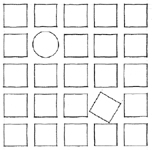
Hierarchy by Placement
A form or space may be strategically placed to call attention to itself as being the most important element in a composition. Hierarchically important locations for a form or space include:
• the termination of a linear sequence or axial organization
• the centerpiece of a symmetrical organization
• the focus of a centralized or radial organization
• being offset above, below, or in the foreground of a composition
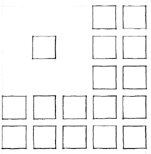
DATUM
Excerpt from Gavotte I, Sixth Cello Suite, by Johann Sebastian Bach (1685–1750). Transcribed for classical guitar by Jerry Snyder.

A datum refers to a line, plane, or volume of reference to which other elements in a composition can relate. It organizes a random pattern of elements through its regularity, continuity, and constant presence. For example, the lines of a musical staff serve as a datum in providing the visual basis for reading notes and the relative pitches of their tones. The regularity of their spacing and their continuity organizes, clarifies, and accentuates the differences between the series of notes in a musical composition.

A preceding section illustrated the ability of an axis to organize a series of elements along its length. In effect, the axis was serving as a datum. A datum, however, need not be a straight line. It can also be planar or volumetric in form.
To be an effective ordering device, a linear datum must have sufficient visual continuity to cut through or bypass all of the elements being organized. If planar or volumetric in form, a datum must have sufficient size, closure, and regularity to be seen as a figure that can embrace or gather together the elements being organized within its field.
Given a random organization of dissimilar elements, a datum can organize the elements in the following ways:
A line can cut through or form a common edge for the pattern, while a grid of lines can form a neutral, unifying field for the pattern.

A plane can gather the pattern of elements beneath it or serve as an encompassing background for the elements and frame them in its field.

A volume can collect the pattern of elements within its boundaries or organize them along its perimeter.

RHYTHM
Rhythm refers to any movement characterized by a patterned recurrence of elements or motifs at regular or irregular intervals. The movement may be of our eyes as we follow recurring elements in a composition, or of our bodies as we advance through a sequence of spaces. In either case, rhythm incorporates the fundamental notion of repetition as a device to organize forms and spaces in architecture.
Almost all building types incorporate elements that are by their nature repetitive. Beams and columns repeat themselves to form repetitive structural bays and modules of space. Windows and doors repeatedly puncture the surfaces of a building to allow light, air, views, and people to enter the interior. Spaces often recur to accommodate similar or repetitive functional requirements in the building program. This section discusses the patterns of repetition that can be utilized to organize a series of recurring elements, and the resultant visual rhythms these patterns create.

REPETITION
We tend to group elements in a random composition according to:
• their closeness or proximity to one another
• the visual characteristics they share in common
The principle of repetition utilizes both of these concepts of visual perception to order recurring elements in a composition.
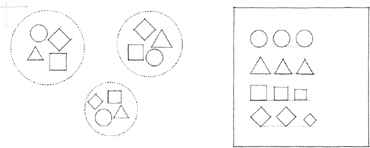
The simplest form of repetition is a linear pattern of redundant elements. Elements need not be perfectly identical, however, to be grouped in a repetitive fashion. They may merely share a common trait or a common denominator, allowing each element to be individually unique, yet belong to the same family.
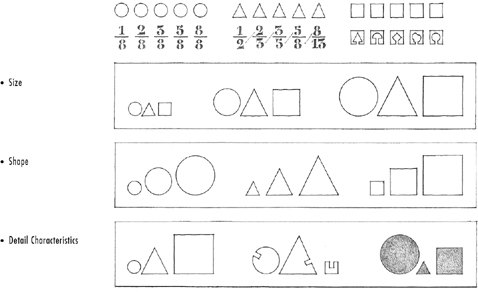
Classification of Temples according to the arrangements of the colonnades. From Book III, Chapter II of Vitruvius’ Ten Books on Architecture.
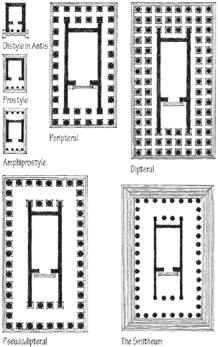
Structural patterns often incorporate the repetition of vertical supports at regular or harmonious intervals which define modular bays or divisions of space. Within such repetitive patterns, the importance of a space can be emphasized by its size and placement.
As in music, a rhythmic pattern may be legato, continuous, and flowing, or staccato and abrupt in its pace or cadence.
Rhythmic patterns provide continuity and lead us to anticipate what comes next. Any break in the pattern announces and emphasizes the importance of the interrupting element or interval.
Multiple rhythms can be laid over one another in the facade of a building.
More complex rhythmic patterns can be created by introducing points of emphasis or exceptional intervals into a sequence. These accents or beats help differentiate between the major and minor themes in a composition.
The radial segments of a nautilus shell spiral outward in a reverberating manner from its center and maintain the shell’s organic unity through this pattern of additive growth. Using the mathematical ratio of the Golden Section, a series of rectangles can be generated to form a unified organization wherein each rectangle is proportionate to the others as well as to the overall structure. In each of these examples, the principle of reverberation creates a sense of order among a group of elements which are similar in shape but hierarchically graded in size.

Progressive, reverberating patterns of forms and spaces can be organized in the following ways:
• in a radial or concentric manner about a point
• sequentially according to size in a linear fashion
• randomly but related by proximity as well as similarity of form
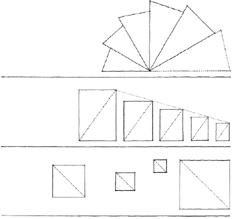
Plan and section: Central circular structures of the Guachimonton complex at Teuchitlán, A.D. 300–800
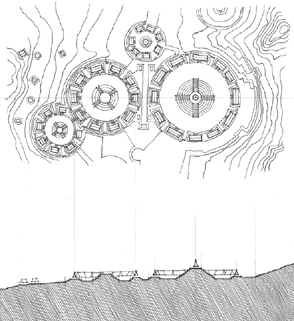
TRANSFORMATION
The study of architecture, as with other disciplines, should legitimately involve the study of its past, of prior experiences, endeavors, and accom-plishments from which much can be learned and emulated. The principle of transformation accepts this notion; this book, and all of the examples it contains, is predicated on it.

The principle of transformation allows a designer to select a prototypical architectural model whose formal structure and ordering of elements might be appropriate and reasonable, and to transform it through a series of discrete manipulations in order to respond to the specific conditions and context of the design task at hand.

Design is a generative process of analysis and synthesis, of trial and error, of trying out possibilities and seizing opportunities. In the process of exploring an idea and probing its potential, it is essential that a designer understand the fundamental nature and structure of the concept. If the ordering system of a prototypical model is perceived and understood, then the original design concept can, through a series of finite permutations, be clarified, strengthened, and built upon, rather than destroyed.

Transformation of a Cruciform Plan Organization by Frank Lloyd Wright
CONCLUSION
Meaning in Architecture
This book, throughout its presentation of the elements of form and space, has been concerned primarily with the visual aspects of their physical reality in architecture. Points, moving through space and defining lines, lines defining planes, planes defining volumes of form and space. Beyond these visual functions, these elements, by their relationships to one another and the nature of their organization, also communicate notions of domain and place, entry and path of movement, hierarchy and order. These are presented as the literal, denotative meanings of form and space in architecture.
As in language, however, architectural forms and spaces also have connotative meanings: associative values and symbolic content that are subject to personal and cultural interpretation, which can change with time. The spires of a Gothic cathedral can stand for the realm, values, or goals of Christianity. The Greek column can convey the notion of democracy, or, as in America in the early 19th century, the presence of civilization in a new world.
Although the study of connotative meanings, of semiotics and symbology in architecture, is beyond the scope of this book, it should be noted here that architecture, in combining form and space into a single essence, not only facilitates purpose but communicates meaning. The art of architecture makes our existence not only visible but meaningful.

“You employ stone, wood, and concrete, and with these materials you build houses and palaces. That is construction. Ingenuity is at work.
But suddenly, you touch my heart, you do me good. I am happy and I say: ‘This is beautiful.’ That is architecture. Art enters in.
My house is practical. I thank you, as I might thank Railway engineers, or the Telephone service. You have not touched my heart.
But suppose that walls rise toward heaven in such a way that I am moved. I perceive your intentions. Your mood has been gentle, brutal, charming, or noble. The stones you have erected tell me so. You fix me to the place and my eyes regard it. They behold something which expresses a thought. A thought which reveals itself without wood or sound, but solely by means of shapes which stand in a certain relationship to one another. These shapes are such that they are clearly revealed in light. The relationships between them have not necessarily any reference to what is practical or descriptive. They are a mathematical creation of our mind. They are the language of Architecture. By the use of raw materials and starting from conditions more or less utilitarian, you have established certain relationships which have aroused my emotions. This is Architecture.”
Le Corbusier
Towards a New Architecture
1927
